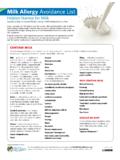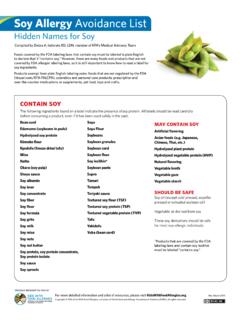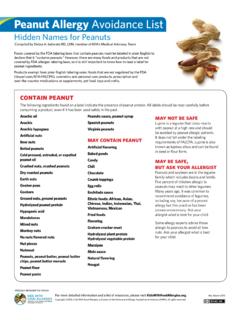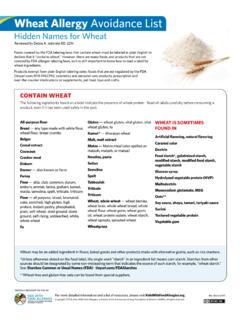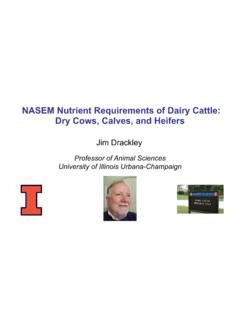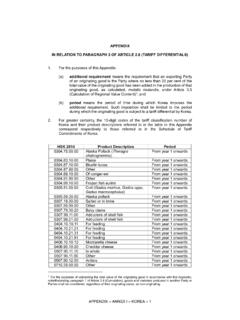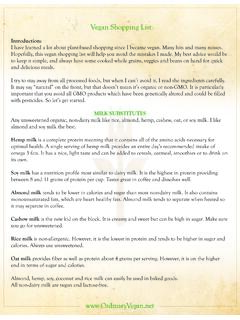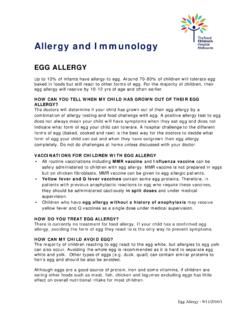Transcription of A Guide to Managing Milk Allergy November 2021
1 Cow s milk Allergy (usually just called milk Allergy ) is a very common food Allergy . A milk Allergy is an immune system reaction to milk protein. It can cause a severe allergic reaction called anaphylaxis [anna-fih-LACK-sis]. If allergic to milk , remove milk from the diet to prevent allergic reactions. This includes all milk products, as well as lactose-free versions of milk products. milk Allergy is different than lactose intolerance (an inability to digest the milk sugar known as lactose). WHAT ARE SYMPTOMS OF AN ALLERGIC REACTION TO milk ?Symptoms of anaphylaxis may include hives, vomiting, or trouble breathing. The treatment for anaphylaxis is injectable epinephrine. Common signs and symptoms of anaphylaxis in children, teens, and adults: Skin rash, itching, hives Swelling of the lips, tongue, or throat Shortness of breath, trouble breathing, wheezing (whistling sound during breathing) Stomach pain, vomiting, or diarrhea Uterine cramps Feeling like something awful is about to happenCommon signs and symptoms of anaphylaxis in infants and toddlers: Skin rash, itching, hives Swelling of the lips, tongue, or throat; ear pulling, scratching or putting fingers in ears.
2 Tongue thrusting or pulling Coughing, wheezing, hoarse cry, noisy breathing, chest or neck tugging, nostril flaring Stomach pain, vomiting, diarrhea, spitting up, hiccups Arching back, bringing knees to the chest Rubbing eyes, itchy or red eyes Other signs and symptoms of a milk Allergy may include: Blood in stools, especially in infants Loose stools Upset stomach, stomach cramps Failure to thrive (slow to grow or gain weight)A Guide to Managing milk ALLERGYMILK INGREDIENT LISTHOW CAN I PREVENT milk Allergy REACTIONS? milk can be found in almost any type of food. Foods that contain milk include ice creams, frozen desserts, cakes, pies, cookies, cream sauces, pasta dishes, casseroles, mashed potatoes, breaded meats, and much more.
3 But there are ways you can successfully manage your milk Allergy . This can be done by: Working with your doctor Reading labels Being aware of cross-contact (when foods come into contact with each other and may transfer an allergen into a food that shouldn t have it) Clearly communicating with people who prepare your food or provide care or accommodationsReading LabelsBy law, food companies must label their products clearly if they contain milk . When reading labels for milk , look for milk to be labeled either in parentheses after an ingredient in the ingredient list or in a statement under the ingredient list. Sometimes it will be in bold. For example: Whey ( milk ) Contains: MilkSome food companies put advisory statements on their labels.
4 They may say may contain milk or made in a facility with milk . These labels can be confusing and may not tell you the actual risk of the product. Ask your doctor if it is OK to eat products with advisory labels. Some foods and products do not have to follow the Allergy label law and may contain hidden milk : Arts and crafts supplies Prescription and over-the-counter drugs Cosmetics and personal care items (such as, makeup, lotions, and soaps) Alcohol To y s Pet food Food served in restaurants, cafeterias, or by other food service providersMost states in the do not have regulations regarding food allergies and in restaurant foods may vary. Cross-contact is also more likely. Look for places that have food Allergy policies and Allergy menus.
5 Give the staff a chef card that alerts them to your Allergy and lists milk . Some foods may be labeled with terms that may imply that the food is free of milk . But they may contain milk ingredients and be unsafe for milk Allergy . Always read the ingredient labels even on foods with these terms: Non-dairy Dairy-free, milk -free Vegan Animal-free dairy/ milk Plant-based Kosher/kosher dairyGoat s and sheep s milk If you are allergic to cow s milk , there is a very high chance you will react to milk from other mammals, such as goats or Guide to Managing milk AllergyIf a food item does not have a label, you can t read it, or you have any doubts, don t eat it. Always read the entire label every time. Food companies may change their and BakingYou can find a lot of milk substitutes made from legumes, seeds, nuts, and grains.
6 These include rice, hemp, soy, sunflower, oat, coconut, almond, and cashew milks. You can usually use any of these as a one-for-one replacement for milk in recipes. For example, if a recipe calls for one cup of milk , you can use one cup of soy milk . Unsweetened and unflavored versions tend to work best in cooking, you can substitute non-dairy margarine or oils in equal amounts for butter. milk -free yogurt, sour cream, ice cream, and cream cheese products are available at many grocery stores. Be sure to check the labels to make sure they don t contain milk Cross-ContactCross-contact occurs when a food allergen comes in contact with food or an item not intended to contain that allergen. If you have both safe and unsafe versions of similar items (like cow s milk and soy milk ) in your home, take steps to make sure they are easily marked.
7 If the containers look the same, create a system for your family to prevent accidents. It may be helpful to use colored stickers or to store the food with the allergen on a different shelf. When you re cooking, use separate utensils and kitchenware. For example, don t use the same knife to cut cow s milk cheese as you use to cut a sandwich made without milk ingredients. provided by mammal milk include protein, calcium, vitamin D, vitamin A, vitamin B12, riboflavin, and phosphorus. Make sure your milk -free diet includes foods with these nutrients. Can I Eat Baked milk or Eggs? About 70% of children with a milk Allergy can eat baked or extensively heated milk . Talk with your doctor about whether or not you can have baked milk before you attempt to introduce it.
8 There is a chance for a severe allergic reaction. People with a milk Allergy can eat eggs even though they are sold in the dairy aisle in stores. Eggs are not dairy. Dairy products are only made with milk . Kids With Food Allergies has many resources to help you manage food allergies. Search our Safe Eats Allergy -Friendly Recipes Collection of almost 1,500 member-submitted recipes at: KFA s milk Chef Cards: Guide to Managing milk AllergyMILK INGREDIENT LISTCONTAINS MILKMilk acidophilus milk , buttermilk, buttermilk blend, buttermilk solids, cultured milk , condensed milk , dried milk , dry milk solids (DMS), evaporated milk , fat-free milk , fully cream milk powder, goat s milk , Lactaid milk , lactose free milk , lactose, lactic acid starter culture, low fat milk , malted milk , milk derivative, milk powder, milk protein, milk solids, milk solid pastes, nonfat dry milk , nonfat milk , nonfat milk solids, pasteurized milk , powdered milk , sheep s milk , skim milk , skim milk powder, sour milk , sour milk solids, sweet cream buttermilk powder, sweetened condensed milk , sweetened condensed skim milk , whole milk , 1% milk , 2% milk , non-dairy productsAnimal-free dairy animal-free dairy protein, non-animal whey protein, animal-free milkButter artificial butter, artificial butter flavor, butter, butter extract, butter fat, butter flavored oil.
9 Butter solids, dairy butter, natural butter, natural butter flavor, whipped butterCasein and caseinates ammonium caseinate, calcium caseinate, hydrolyzed casein, iron caseinate, magnesium caseinate, potassium caseinate, sodium caseinate, zinc caseinate Cheese cheese (all types and in all forms), cheese flavor (artificial and natural), cheese food, cottage cheese, cream cheese, imitation cheese, cheese dip, vegetarian cheeses with caseinCream whipped cream, whipping cream, heavy cream, cream cheeseCurdsCustardDairy product solidsGalactoseGheeHalf & HalfHydrolysates casein hydrolysate, milk protein hydrolysate, protein hydrolysate, whey hydrolysate, whey protein hydrolysate Ice cream, ice milk , sherbetLactalbumin, lactalbumin phosphateLactate solidsLactitol monohydrateLactoglobulinLactoseLactulose milk fat, anhydrous milk fatNougat (can contain milk chocolate)PuddingQuark RECALDENT Rennet, rennet caseinSIMPLESSE (fat replacer)
10 Sour cream, sour cream solids, imitation sour creamWhey acid whey, cured whey, delactosed whey, demineralized whey, hydrolyzed whey, powdered whey, reduced mineral whey, sweet dairy whey, whey, whey protein, whey protein concentrate, whey powder, whey solidsYogurt (regular or frozen) Yogurt powderMILK IS SOMETIMES FOUND INFlavoring, natural flavoring Caramel flavoring High protein flour LactoseNisin preparation or preservative Non-dairy products (may contain casein) such as non-dairy creamer Plant-based foodsRice cheeseSoy cheeseVegan foods a new animal-free milk protein may be found in vegan ice creams or other productsSHOULD BE SAFET hese milk derivatives should be safe for most people with a milk Allergy but talk with your doctor before eating.

